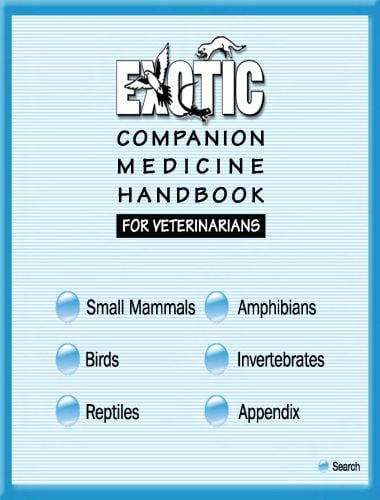“Exotic Companion Medicine Handbook For Veterinarian ” began as a way for me to organize all my quick reference notes, diagnostic and clinical pathology charts, formularies, lists, and other clinical notes that I found I needed close at hand during practice.
Exotic Companion Medicine Handbook For Veterinarian

The very nature of avian and exotic animal practice requires drawing from many reference sources. Diverse continuing education courses and the switching of mental gears between office calls requires far more knowledge than one is prepared for in traditional small animal practice.
his quick reference guidebook is for you to personalize and develop in ways that best suit your individual role in animal care. The Exotic Companion Medicine Handbook for Veterinarians consists of two 13-ring pocket-sized binders and 23 color-coded tabs.
The chapters with general headings of Small Mammals, Birds, Reptiles, Amphibians and Invertebrates cover topics that apply to all members of the Class. Information on a specific Order is presented within its separate chapter. Each chapter begins with a contents page so the abbreviated topics can be located more quickly. In cases where several segments are included in a chapter (eg, Rats, Mice, Gerbils, Hamsters in SMALL RODENTS), an individual contents page is provided for each segment. The material within each tabbed section is numbered consecutively for that section alone.
The idea of creating a concise, pocket reference source became a reality. This publication contains the information needed quickly by anyone working with companion birds, rabbits, rodents, ferrets, hedgehogs, reptiles, amphibians, invertebrates and other species frequently or even occasionally encountered by veterinarians. We put it in notebook form so the clinician could customize and rearrange pages to fit his/her personal information needs. We kept the size of the book small enough to be carried in a laboratory coat pocket. This book was designed for veterinarians, veterinary technicians and students. Much of this information may be of use to others in other fields who work with animals. We hope you find the “handbook” very useful and welcome your comments on this project.
Although every effort has been made to ensure the accuracy of the contents, particularly drug doses, it is the responsibility of the clinician to critically evaluate the contents, to stay informed of pharmacokinetic information and to observe recommendations provided by manufacturers.
| PDF Size: 4 MB | Book Download Free |
Password: pdflibrary.net
